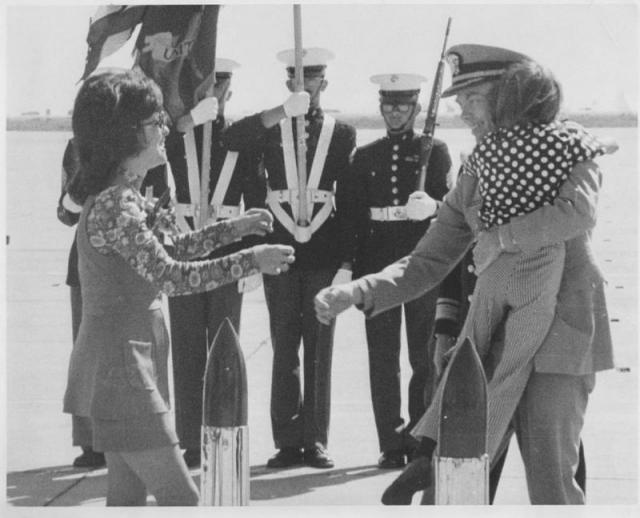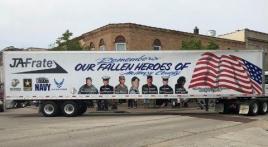Above: Dr. Bob Shumaker reuniting with his family after more than eight years in captivity.
National POW/MIA Recognition Day is Sept. 19, 2014. But the mass movement to raise awareness for these servicemembers took place during the Vietnam War. The wives of POWs tortured and kept for years launched a fight to bring back prisoners of war and determine the fate of the men missing in action. Meanwhile, the men, especially the members of Alcatraz 11 — senior-level POWs that the North Vietnamese identified as resistance leaders — underwent isolation and torture.
The group included James Stockdale, Bob Shumaker, Jeremiah Denton, George Coker, Sam Johnson, James Mulligan, Howard Rutledge, Harry Jenkins, George McKnight, Nels Tanner and Ronald Storz. Stockdale later received the Medal of Honor and ran for vice president. Johnson serves as a congressman from Texas, and Denton served as a senator from Alabama. Storz died in the Vietnamese prison known as Alcatraz.
When Shumaker was deployed to Vietnam in 1965, his son was 3 weeks old. His wife was 21. He wouldn't see them again for eight years.
"When I got shot down the airplane flipped out of control and I ejected, and in the process managed to break my back. I evaded for about two or three hours and then the Vietnamese finally got me and took me up to Hanoi, where the main prison was," Shumaker said.
Shumaker was the second POW at Hoa Lo Prison, and coined its ironic nickname: the Hanoi Hilton.
"It was anything but the Hilton," said Alvin Townley, the author of "Defiant," a book about the Alcatraz 11, and friend of the group’s surviving members.
Townley said the men were only allowed out of their cells once a day — to empty the buckets they used as latrines. These once-confident pilots were stripped, beat, kicked, he said. "They weren’t allowed to communicate, they were interrogated, they didn't get any mail and weren’t really allowed to write home."
While POWs faced years of abysmal conditions, at home, their wives, many of whom were raising large families, wondered when or whether they'd return. Fortunately, the Vietnamese had released Shumaker’s name as a POW, so his wife knew he was alive.
Other families were left in the dark. Louise Mulligan, James' wife, recalled a woman who had only been married seven days when her husband went missing. He never came home. Another wife whose husband had been declared dead, "she had collected insurance and everything," walked out to her mailbox one day and had a letter from him.
Louise herself knew her husband had ejected into a rice paddy and captured on March 20, 1966, but didn't know until July that he survived.
The government advised the POW/MIA families to "keep quiet," not talk to the press, “because the government was worried anything they said might endanger their husbands or might upset the North Vietnamese," Townley said.
But the families would later find out the men "were getting tortured anyway,” Louise said.
"Basically they would tie these guys up with rope, and just bend them until they broke," Townley said. "They tried not to give up any intelligence, they tried not to sign the confessions, but at some point, when you're in that much pain you just, you break. And that's what happened."
Afterward, the prisoners would return to their cells in tears, "until they realized that everybody had broken," Townley said.
A man put in Shumaker's cell remembered a tap code — a five-by-five grid of the alphabet (excluding K) — that let them to communicate without the Vietnamese catching on to the code.
"They would tap twice for each letter. The first tap would represent the letter's row, and the second tap would represent the letter's column," Townley said. "They would just sit there and tap on the wall. Sometimes they'd cough in codes, sometimes they'd sweep floors in code. They were always communicating, always trying to keep each other's spirits up. ... Sometimes they said that the Hanoi Hilton sounded like a den of woodpeckers because these guys were just tapping on the walls."
Shumaker said they could transmit four or five words per minute using this technique. It served as their main means of communication.
Shumaker, along with 10 other leaders, were sent to Alcatraz in fall 1967. They came to be known as the Alcatraz 11.
"Imagine how bad you’d have to be to get kicked out of POW camp," Townley said.
"We were leading the others, trying to set policies about how to resist and how far to go in taking torture and things," Shumaker said. "Our policy was to teach people to get back up off the canvas and steel their reserves so they could come back into the fight."
Alcatraz proved much worse than Hoa Lo, and they stayed there over two years. The men lived in solitary confinement in 4-by-9-foot concrete cells.
"No windows. No latrine. These guys just had to survive in this little box," Townley said. "They were tortured but even worse than straight torture, they were just bored."
The men kept their minds sharp through use. Shumaker, trained as an engineer, turned to mathematics and construction.
"I'd build a house in my mind. I knew how many bricks and nails and things were in it. That took me probably about two years to build this house," he said.
The men passed along lessons, tapping through the wall, each making a different contribution — one knew a lot about cars, so he might share how to change oil, another knew about fixing televisions, and so on.
"They may be short little lessons but we had a lot of time. ... So we took care of each other and supported each other," Shumaker said.
A man on one side of Shumaker's cell wanted to learn French.
"So I would tap five words of French to him a day. In the two-and-a-half year's time we were there, I never got more than 10 feet away from this guy but I never saw him," he said.
Back at home, wives were learning new things, too — public speaking, public relations and campaigning.
They organized. Jane Denton and Louise helped lead the charge in the Virginia Beach - area, Sybil Stockdale on the West Coast. All three were wives of Alcatraz men. All three were raising large families.
"You really don't want to get women angry," Louise said. "We got a little tired of doing nothing and so we started to organize."
After keeping quiet for a long time, in the late 1960s, many wives decided to go public.
"We were treated well. I could call the White House," Louise said. "The doors were open. Once we went public, they certainly were accommodating, they just didn't move fast enough."
"These women rose up, broke the government policy, started the nationwide POW/MIA movement and basically rallied America around the common cause of bringing home our POWs," Townley said.
"We were housewives. We were not used to doing things public," Mulligan said. But soon, she’d give speeches to crowds of hundreds.
The women started a letter-writing campaign to flood Paris during negotiations. They spoke with the press. They marched in Washington, D.C. This movement produced the National League for POW/MIA Families.
"The Vietnam War was so divisive," Townley said. "But these women united America around this one common thing that they could agree on and that was the safe return of our POWs."
The awareness spread and fervor caught on. The National League worked with the West Coast college students that had begun a bracelet and T-shirt campaign with the now-iconic POW/MIA image on it. More than 5 million bracelets were sold.
"I'm still convinced that we helped because they started getting better treatment," she said. She said the North Vietnamese adjusted prisoners' diets, and the men were moved back to the Hanoi Hilton — following an unsuccessful rescue attempt at another prison.
"It was there that I met for the first time this guy that I taught French to. And he could speak French better than I could by that time," Shumaker said. It was Johnson.
Eventually the POWs were released. The prisoners from the Hanoi Hilton came home in three waves, beginning in February 1973.
Shumaker reunited with his "motivation," his wife and now 8-year-old son.
Louise met James with their six sons when he landed at Norfolk. She said it was late and "everything was blaring."
"I realized at the time that it was unproductive to look backwards and lament because you had maybe 30, 40, 50 years to live. Might as well look forward, and that's what I did," Shumaker said.
He retired from the Navy as a rear admiral.
Shumaker and Mulligan stressed their gratitude to the American volunteers and voices.
"The American people never forgot us, and it was through their efforts that we got released. So we feel a great measure of debt to the American public," Shumaker said.
The surviving six of the Alcatrez 11 still stay in touch. Denton died earlier this year, and the Legion recently passed a resolution to support the Navy naming a ship in his honor.
"I learned I’m not quite as smart as I thought I was I guess," Shumaker said. "But on the flipside, I learned it's really important to communicate with your friends and to solicit their advice, and to support them when they're down. That experience I had really solidified that lesson for me."



